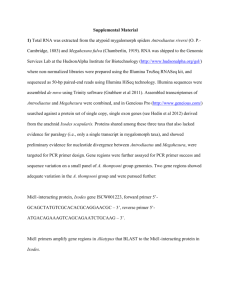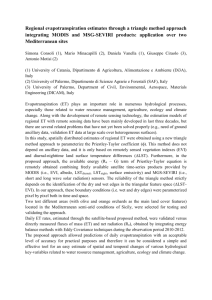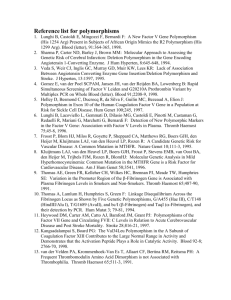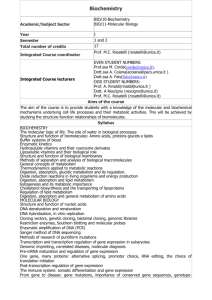The eaeA gene is not found in Hafnia alvei from patients with
advertisement
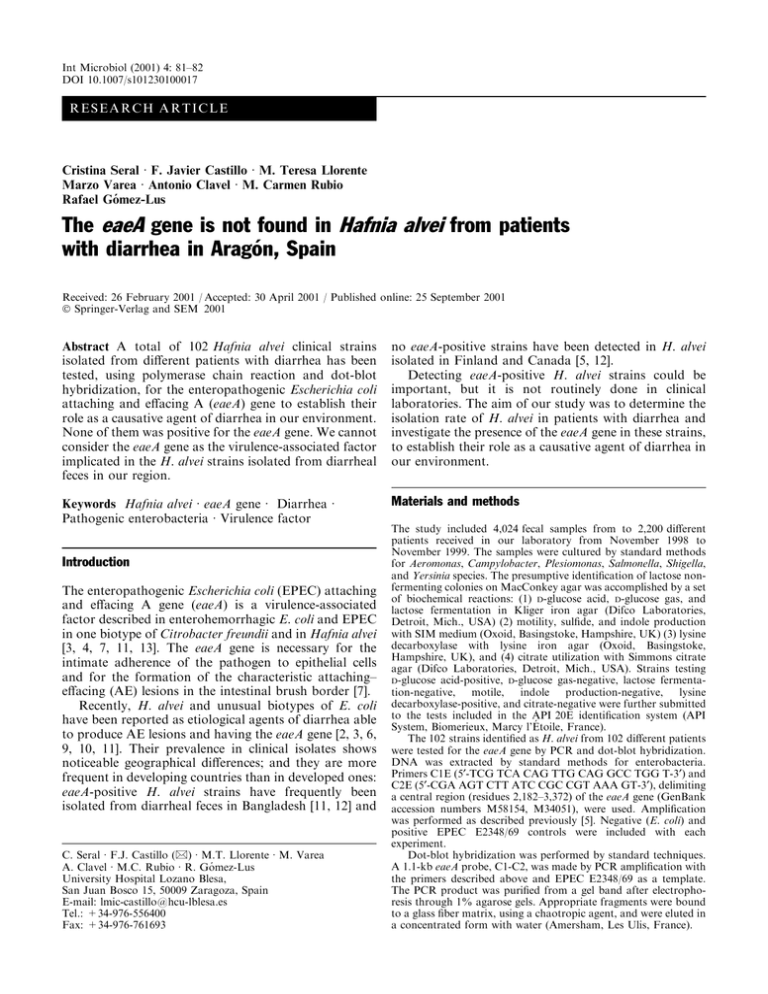
Int Microbiol (2001) 4: 81±82 DOI 10.1007/s101230100017 R ES E AR C H A RT I C L E Cristina Seral á F. Javier Castillo á M. Teresa Llorente Marzo Varea á Antonio Clavel á M. Carmen Rubio Rafael GoÂmez-Lus The eaeA gene is not found in Hafnia alvei from patients with diarrhea in AragoÂn, Spain Received: 26 February 2001 / Accepted: 30 April 2001 / Published online: 25 September 2001 Ó Springer-Verlag and SEM 2001 Abstract A total of 102 Hafnia alvei clinical strains isolated from dierent patients with diarrhea has been tested, using polymerase chain reaction and dot-blot hybridization, for the enteropathogenic Escherichia coli attaching and eacing A (eaeA) gene to establish their role as a causative agent of diarrhea in our environment. None of them was positive for the eaeA gene. We cannot consider the eaeA gene as the virulence-associated factor implicated in the H. alvei strains isolated from diarrheal feces in our region. no eaeA-positive strains have been detected in H. alvei isolated in Finland and Canada [5, 12]. Detecting eaeA-positive H. alvei strains could be important, but it is not routinely done in clinical laboratories. The aim of our study was to determine the isolation rate of H. alvei in patients with diarrhea and investigate the presence of the eaeA gene in these strains, to establish their role as a causative agent of diarrhea in our environment. Keywords Hafnia alvei á eaeA gene á Diarrhea á Pathogenic enterobacteria á Virulence factor Materials and methods Introduction The enteropathogenic Escherichia coli (EPEC) attaching and eacing A gene (eaeA) is a virulence-associated factor described in enterohemorrhagic E. coli and EPEC in one biotype of Citrobacter freundii and in Hafnia alvei [3, 4, 7, 11, 13]. The eaeA gene is necessary for the intimate adherence of the pathogen to epithelial cells and for the formation of the characteristic attaching± eacing (AE) lesions in the intestinal brush border [7]. Recently, H. alvei and unusual biotypes of E. coli have been reported as etiological agents of diarrhea able to produce AE lesions and having the eaeA gene [2, 3, 6, 9, 10, 11]. Their prevalence in clinical isolates shows noticeable geographical dierences; and they are more frequent in developing countries than in developed ones: eaeA-positive H. alvei strains have frequently been isolated from diarrheal feces in Bangladesh [11, 12] and C. Seral á F.J. Castillo (&) á M.T. Llorente á M. Varea A. Clavel á M.C. Rubio á R. GoÂmez-Lus University Hospital Lozano Blesa, San Juan Bosco 15, 50009 Zaragoza, Spain E-mail: lmic-castillo@hcu-lblesa.es Tel.: +34-976-556400 Fax: +34-976-761693 The study included 4,024 fecal samples from to 2,200 dierent patients received in our laboratory from November 1998 to November 1999. The samples were cultured by standard methods for Aeromonas, Campylobacter, Plesiomonas, Salmonella, Shigella, and Yersinia species. The presumptive identi®cation of lactose nonfermenting colonies on MacConkey agar was accomplished by a set of biochemical reactions: (1) D-glucose acid, D-glucose gas, and lactose fermentation in Kliger iron agar (Difco Laboratories, Detroit, Mich., USA) (2) motility, sul®de, and indole production with SIM medium (Oxoid, Basingstoke, Hampshire, UK) (3) lysine decarboxylase with lysine iron agar (Oxoid, Basingstoke, Hampshire, UK), and (4) citrate utilization with Simmons citrate agar (Difco Laboratories, Detroit, Mich., USA). Strains testing D-glucose acid-positive, D-glucose gas-negative, lactose fermentation-negative, motile, indole production-negative, lysine decarboxylase-positive, and citrate-negative were further submitted to the tests included in the API 20E identi®cation system (API System, Biomerieux, Marcy l'EÂtoile, France). The 102 strains identi®ed as H. alvei from 102 dierent patients were tested for the eaeA gene by PCR and dot-blot hybridization. DNA was extracted by standard methods for enterobacteria. Primers C1E (5¢-TCG TCA CAG TTG CAG GCC TGG T-3¢) and C2E (5¢-CGA AGT CTT ATC CGC CGT AAA GT-3¢), delimiting a central region (residues 2,182±3,372) of the eaeA gene (GenBank accession numbers M58154, M34051), were used. Ampli®cation was performed as described previously [5]. Negative (E. coli) and positive EPEC E2348/69 controls were included with each experiment. Dot-blot hybridization was performed by standard techniques. A 1.1-kb eaeA probe, C1-C2, was made by PCR ampli®cation with the primers described above and EPEC E2348/69 as a template. The PCR product was puri®ed from a gel band after electrophoresis through 1% agarose gels. Appropriate fragments were bound to a glass ®ber matrix, using a chaotropic agent, and were eluted in a concentrated form with water (Amersham, Les Ulis, France). 82 Fig. 1 Dot-blot hybridization performed with a 1.1-kb eaeA probe. None of the Hafnia alvei isolates were positive for the eaeA gene (lanes 1±6). Enteropathogenic Escherichia coli E2348/69 was the positive control (lanes 7±10) The probes were labeled with (a32P)-dCTP as recommended by the manufacturer (Amersham, Les Ulis, France). Hybridization was carried out at 60 °C overnight. Filters were exposed to Hyper®lm ECL (Hyper®lm-ECL RPN2103, Amersham International, Buckinghamshire, UK) for 18±20 h. The presence of DNA on the membranes was assessed with the eaeA probe following rehybridization. in the sequence of the 16S rRNA between these strains and the EPEC strain E2348/69. Janda et al. [6] thoroughly studied ®ve eaeA-positive strains identi®ed by Albert et al. [3] as H. alvei with API 20E. Some biochemical reactions (negative Voges±Proskauer reaction and the inability to ferment l-rhamnose) suggested that these strains might not be hafniae; and further tests supported their identi®cation as Escherichia spp. Our strains did not show atypical reactions for Hafnia, so we can consider them H. alvei. It would be interesting to investigate the eaeA gene in unusual biotypes of E. coli. In conclusion, we did not ®nd any eaeA-positive H. alvei strains; and so, we cannot consider our H. alvei strains as diarrheagenic pathogens unless other virulence-associated factors were implicated. These strains were isolated from stools of patients suering diarrhea, but their etiological relationship to enteritis is unclear. It is possible that they were transient organisms and a part of the commensal ¯ora of the intestine [8]. More studies are needed to de®ne the role of both H. alvei and atypical E. coli as agents of diarrhea. Results Within the 1-year period of study, a total of 625 diarrheagenic bacterial strains were isolated. They belonged to the following species: Campylobacter spp (274), Salmonella spp (271), Aeromonas spp (33), Y. enterocolitica (32), P. shigelloides (12), and Shigella spp (3). H. alvei was isolated from 117 samples collected from 102 dierent patients. It was found in pure culture in 6 samples. Organisms cultured concomitantly with H. alvei were: Campylobacter spp (2), S. enterica (2), and Y. enterocolitica (2). None of them was more frequently associated with H. alvei. PCR and dot-blot hybridization were performed to investigate the presence of the eaeA gene in the 102 H. alvei isolates. None of them was positive for the eaeA gene (Fig. 1). Discussion Agents of gastroenteritis previously thought to be mere commensals of the gastrointestinal tract have been described [1]. In recent years, several cases of diarrhea due to H. alvei have been reported [2, 3, 9, 10], but few data have been published about the rate of isolation of H. alvei from stool specimens in routine practice and its clinical signi®cance remains to be de®ned [9]. From diarrheic patients in Bangladesh, eaeA-positive H. alvei have been isolated [11, 12]. In Finland and Canada, in contrast, this gene has not been found in H. alvei strains isolated from diarrheal patients, which suggests that there may be other virulence-associated factors [5, 11, 12]. All our H. alvei strains have also been eaeA-negative. Nonetheless, there is another factor to be considered: eaeA-positive ``H. alvei'' isolates could actually be atypical E. coli. Ridell et al. [12] found a high homology References 1. Abbott SL, Janda JM (1992) Bacterial gastroenteritis. I. Incidence and etiological agents. Clin Microbiol Newsl 14: 17±21 2. Albert MJ, Alam K, Islam M, Montanaro J, Rahaman AS, Haider K et al (1991) Hafnia alvei, a probable cause of diarrhea in humans. Infect Immun 59:1507±1513 3. Albert MJ, Faruque SM, Ansaruzzaman M, Islam MM, Haider K, Alam K et al (1992) Sharing of virulence-associated properties at the phenotypic and genetic levels between enteropathogenic Escherichia coli and Hafnia alvei. J Med Microbiol 37:310±314 4. Frankel G, Candy DCA, Everest P, Dougan G (1994) Characterization of the C- terminal domains of intimin-like proteins of enterohemorrhagic Escherichia coli, Citrobacter freundii, and Hafnia alvei. Infect Immun 62:1835±1842 5. Ismaili A, Bourke B, Azavedo JC de, Ratnam S, Karmali MA, Sherman PM (1996) Heterogeneity in phenotypic and genotypic characteristics among strains of Hafnia alvei. J Clin Microbiol 34:2973±2979 6. Janda JM, Abbott SL, Albert MJ (1999) Prototypal diarrheagenic strains of Hafnia alvei are actually members of the genus Escherichia. J Clin Microbiol 37:2399±2401 7. Law D (1994) Adhesion and its role in the virulence of enteropathogenic Escherichia coli. Clin Microbiol Rev 7:152±173 8. Matsumoto H (1963) Studies on the Hafnia isolated from normal human. Jpn J Microbiol 7:105±114 9. Ratnam S (1991) Etiologic role of Hafnia alvei in human diarrheal illness. Infect Immun 59:4744±4745 10. Reina J (1993) Acute gastroenteritis caused by Hafnia alvei in children. Clin Infect Dis 16:443 11. Ridell J, Siitonen A, Paulin L, Mattila L, Korkeala H, Albert MJ (1994) Hafnia alvei in stool specimens from patients with diarrhea and healthy controls. J Clin Microbiol 32:2335±2337 12. Ridell J, Siitonen A, Paulin L, Lindroos O, Korkeala H, Albert MJ (1995) Characterization of Hafnia alvei by biochemical tests, random ampli®ed polymorphic DNA PCR, and partial sequencing of 16S rRNA gene. J Clin Microbiol 33:2372±2376 13. Schauer DB, Falkow S (1993) The eae gene of Citrobacter freundii biotype 4280 is necessary for colonization in transmissible murine colonic hyperplasia. Infect Inmmun 61: 4654±4661

